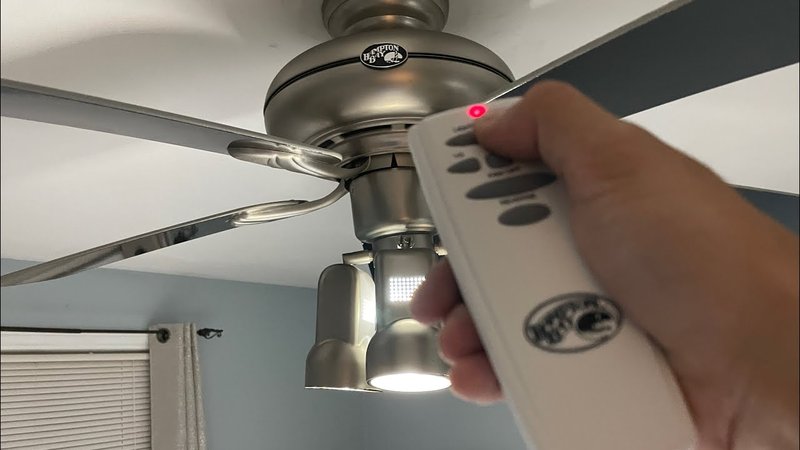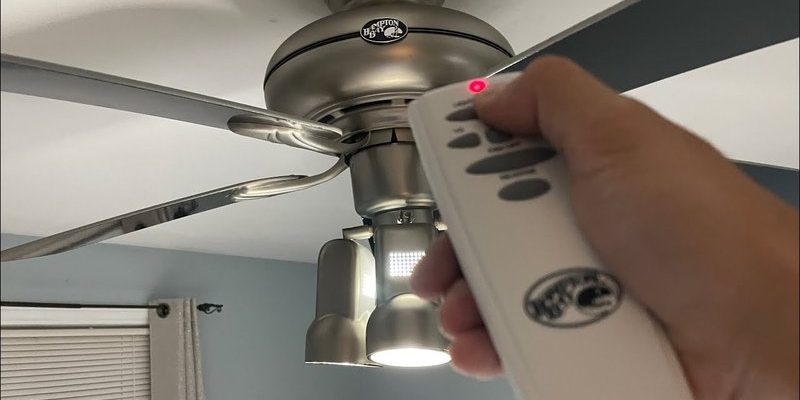
But here’s the kicker: not everyone realizes their Hampton Bay remote can do more than just turn the fan on and off. Sometimes, the reverse mode button hides in plain sight, cleverly disguised among other buttons you barely notice. If you’ve ever squinted at your remote and wondered, “How do I get this thing to reverse the fan?” — you’re in the right place. Let’s break down exactly how to enable reverse mode on a Hampton Bay ceiling fan remote, step by step, without the tech jargon or frustration.
Understanding Your Hampton Bay Ceiling Fan Remote
So, you’ve got a Hampton Bay ceiling fan, and you’re staring at the remote like it just landed from outer space. Honestly, most remotes look more complicated than they really are. The typical Hampton Bay remote will have several buttons, including speed controls, a light switch, and — somewhere — the magical reverse button.
Not all Hampton Bay remotes are created equal. Some have a clearly labeled “Reverse” or “REV” button; sometimes it looks like two arrows forming a circle. Others might make you press a combination of buttons if the reverse function is tucked away. Here’s the thing: the design depends on the model, and Hampton Bay has quite a few floating around.
If your remote has a digital screen or extra features, it might do even more. Some newer models can even pair or sync with smart home systems, but let’s keep it simple for now. We’re focusing on classic handheld remotes because, let’s face it, those are the ones you find in the bottom of a drawer or buried under couch cushions.
What Reverse Mode Actually Does (And Why It Matters)
You might be wondering: why would anyone want their ceiling fan to spin backward? It sounds like a trick, but it’s actually a clever bit of engineering. Reverse mode changes the direction of the blades, which changes how air moves in the room.
Here’s how it works:
- Summer Mode (Forward): The fan blades spin counterclockwise. This pushes cool air down, giving you that refreshing breeze we all crave during a heatwave.
- Winter Mode (Reverse): The fan blades spin clockwise. Instead of blowing air down, the fan gently pulls cold air up and pushes warm air — which naturally rises — back down along the walls. This helps circulate the warm air sitting by your ceiling, making the room feel cozier.
It’s a simple trick, but it can actually save you money by helping your heating or cooling system work more efficiently. It also gets rid of those annoying “cold spots” in winter or helps beat the stagnant stuffiness in summer.
Think of it as turning your fan into a seasonal secret weapon: cool air in the summer, warm circulation in the winter, all without touching your thermostat.
Step-By-Step: How To Enable Reverse Mode With Hampton Bay Ceiling Fan Remote
Let me explain how to actually get your fan spinning in reverse. Don’t worry about breaking anything — this is a safe, reversible process that takes less than a minute.
Step 1: Locate the Reverse Button
- Look for a button labeled “Reverse,” “REV,” or with a circular arrow symbol.
- If you can’t find it, check if the reverse function is a dual-purpose button (consult your fan’s manual, if you have it; otherwise, Google your model number).
Step 2: Make Sure the Fan Is Running
- Start your fan at any speed. Some Hampton Bay models require the fan to be turning before switching directions.
Step 3: Press the Reverse Button
- Press the button once. You might hear a soft “click” or see the blades slow down and stop before spinning in the opposite direction.
Step 4: Wait for the Fan to Resume
- The fan might pause for a few seconds during the switch — that’s normal. Afterward, it will start spinning in the new direction.
Done! Your fan is now in reverse mode.
*Tip: If the reverse button doesn’t seem to work or you’re not sure you did it right, turn the fan off, wait ten seconds, and try again. Sometimes electronics need a moment to catch up — kind of like people before their morning coffee.
Troubleshooting Hampton Bay Ceiling Fan Reverse Mode
Sometimes things don’t go as smoothly as we’d like. Maybe you press the reverse button, and nothing happens. Maybe the fan beeps or the light blinks, but the blades stubbornly refuse to change direction. Don’t panic — most problems are easy to fix.
Start by checking the batteries in your remote. Weak batteries can cause all sorts of odd issues, from unresponsive buttons to flaky code transmission. Swap out the batteries and try again.
If that doesn’t help, make sure your remote is paired or synced correctly with the fan. Sometimes, power interruptions or electrical surges can cause the fan to “forget” its remote. Usually, you can re-pair the remote by holding down the power button or following a sequence (check your manual or look up your model online for specific pairing codes).
Here’s another common snag: the reverse function might be on the actual fan housing instead of the remote, especially on older models. There could be a tiny slide switch right above the blades. If you’re not finding any response from the remote, give the fan itself a quick check. Safety first: turn off the fan (and the breaker, just to be cautious) before reaching up there.
Finally, resetting the remote or the fan can sometimes clear up stubborn glitches. Turn the fan off at the wall, remove the batteries from the remote, then power back on and try again. Simple, but surprisingly effective.
Comparing Universal Remotes vs. Original Hampton Bay Remotes
You might be tempted to grab a universal remote if your original Hampton Bay remote breaks, goes missing, or just starts acting weird. Seems like a quick fix, right? Here’s the thing: universal remotes can be a bit hit-or-miss when it comes to features like reverse mode.
Original Hampton Bay remotes are always programmed to match all the special functions of their brand. That means every button does exactly what it should, including syncing, pairing, and enabling reverse mode. Universal remotes, on the other hand, sometimes skip advanced features — or they require complex codes to activate.
If you’re set on using a universal remote, read the packaging carefully and check for a “reverse” or “direction” button. And be prepared to enter pairing codes or run through a reset process to get it working. In rare cases, you might lose access to functions like reverse mode, which is a bit like buying a fancy new phone and realizing the camera only does selfies.
For the least hassle, track down an official Hampton Bay remote or a direct replacement. It saves a lot of time (and frustration) in the long run.
How To Tell If Reverse Mode Is Working On Your Fan
You might hit that reverse button and still feel unsure. Is the fan really spinning in the other direction, or does it just look that way? Here’s how to check.
Watch the direction of the blades while standing underneath. In reverse mode (winter), the blades should rotate clockwise. In forward mode (summer), they should spin counterclockwise. If you’re not sure what that means, just pick a blade and watch how it moves — imagine it’s the hand on a clock.
Check the airflow. Stand directly under the fan, and hold up a piece of tissue or your hand. If you feel air blowing down strongly, it’s in forward mode. In reverse mode, you should barely feel airflow directly below; instead, the air circulates more gently along the edges of the room.
Don’t overthink it: if things feel subtly different after switching, you’ve probably done it right. Sometimes, the change is subtle, especially at lower fan speeds.
Remote Battery Tips and Remote Maintenance for Longevity
Here’s something people rarely think about: remotes are only as good as their batteries and connections. If your Hampton Bay ceiling fan remote feels sluggish or inconsistent, the batteries are usually the culprit.
Always use fresh, high-quality batteries. Cheap batteries can leak or lose charge quickly, which messes with the remote’s signal. Swapping batteries every year or so keeps things running smoothly. Dispose of old batteries properly — don’t let them corrode inside your remote.
Clean the battery contacts and button pads. Every few months, pop off the battery door and check for dust or residue. A gentle wipe with a dry cloth can improve the connection and keep the buttons responsive. If you notice stickiness or gunk on the remote’s surface, a little rubbing alcohol on a cotton swab works wonders.
And — I know it’s obvious, but it’s worth saying — don’t drop your remote too often. They’re built tough, but a hard fall can knock something loose, misalign a connection, or crack the casing.
Pairing and Resetting Your Hampton Bay Ceiling Fan Remote
When And Why To Sync Or Reset
Sometimes the fan and remote just stop talking to each other — like two old friends after a bad argument. If your reverse button isn’t working, or if none of the buttons respond, a simple reset or re-pairing can usually fix it.
To pair or sync the remote:
- Turn off the fan using the wall switch (or circuit breaker, if needed).
- Wait about 30 seconds for the electronics to fully power down.
- Turn the power back on.
- Within 30 seconds, press and hold the “Fan” or “Sync” button on your remote for about 5–10 seconds.
- The fan should start moving, or you may hear a beep or see the light blink.
If that doesn’t work, try removing the batteries from the remote, waiting 10 seconds, then popping them back in and trying again.
Resetting clears out any old codes or glitches, giving your system a fresh start — which is especially handy if you just replaced the batteries, moved the fan, or had a power outage.
If you keep having issues, jot down your fan’s model number and look up the specific code or sync instructions for your remote. There’s a ton of variation, and a quick Google search can save you hours of trial and error.
Final Thoughts: Using Hampton Bay Ceiling Fan Reverse Mode All Year Long
Enabling reverse mode with a Hampton Bay ceiling fan remote isn’t rocket science, but it makes a surprising difference in how comfortable your space feels. Once you’ve got the hang of it, you can adjust your ceiling fan for every season — cooler in the summer, cozier in the winter — with just the press of a button. It’s one of those “small win” home upgrades that feels way more satisfying than you’d expect.
Just remember to keep your remote in good shape, check the batteries now and then, and don’t be afraid to troubleshoot if things get weird. If you’ve lost your original remote, tracking down an official replacement is usually worth the extra effort to keep all those built-in features — especially reverse mode — working perfectly.
So next time you feel a chill in the air or the summer heat creeping in, reach for your Hampton Bay remote. With reverse mode enabled, you’re in total control of your comfort — no ladder or tools required.
